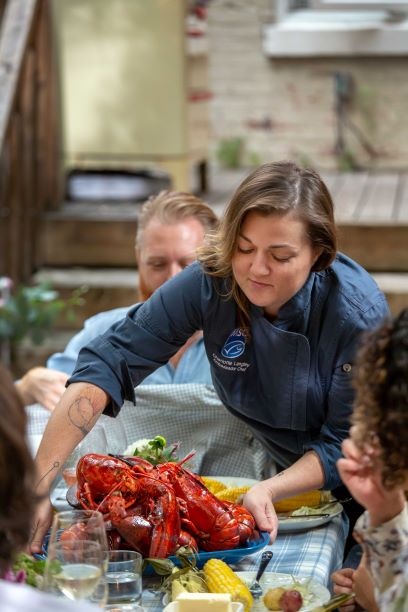Every small choice we make as individuals has a big impact. Choosing sustainable blue foods supports not only a healthy planet but also the livelihoods of the people responsible for taking care of those fisheries and the communities around them.

Ingredients
- 2 lbs MSC certified wild salmon, bones removed (frozen only, in fall)
- 1 cup salt
- 2/3 cup white sugar
- 2 tbsp white sesame seeds
- 1 tbsp dehydrated garlic
- 1 tbsp dehydrated onion
- 2 tbsp poppy seeds
- 2 day old plain bagels, sliced
- 1 tbsp olive oil
- ½ cup room temperature cream cheese
- Capers
- Fresh lemon
- Fresh dill
Method
1. Mix together salt and sugar and fully coat the salmon in mixture on both sides.
2. Place between two cookie sheets of the same size and place in fridge overnight (at least 12 hours) with a small amount of weight on the top.
Tip: The weight on top will help make the surface area covered by the cure more consistent and reduce waste by eliminating the need to trim too much off the sides.
Assembly:
1. Preheat oven to 350˚F
2. Remove fish from the fridge, rinse and pat dry. Set aside while you mix your everything spice.
3. Mix all the dry spices together (sesame seeds, dehydrated garlic, dehydrated onion, poppy seeds and toss the salmon in the mixture. Let sit in the fridge, unwrapped while you prepare the bagels and assemble your garnishes.
4. Slice the day-old bagels into thin pieces, drizzle lightly with olive oil and toast lightly
5. Cut your salmon straight up and down into slices approximately 2 cm thick.
6. Smear each bagel crisp with some cream cheese, top with one salmon slice, a sprig of dill, 1-2 capers and a squeeze of lemon
7. Arrange on a platter and pass to your guests or serve family style on the table
8. Store unused salmon in the fridge in a tightly sealed container for 3 -5 days.
TIP: Frozen salmon fillets will work just as well. Simply thaw in the fridge overnight, and dry thoroughly on paper towel. Fresh wild salmon season typically begins in June, so keep this recipe handy for next summer!
Chef Charlotte Langley
Charlotte Langley hails from PEI where she cultivated a ‘Maritime Chic’ style of cooking and a deep love for the oceans. She aims to nurture and inspire through food with consciously selected ingredients that celebrate season, terroir and the delicate ecosystems that sustain us. Constantly challenging herself and what it means to be a chef, Charlotte founded Nice Cans, and through her role as ambassador for the Marine Stewardship Council (MSC) she champions the importance of choosing seafood that is both sustainable and traceable.



